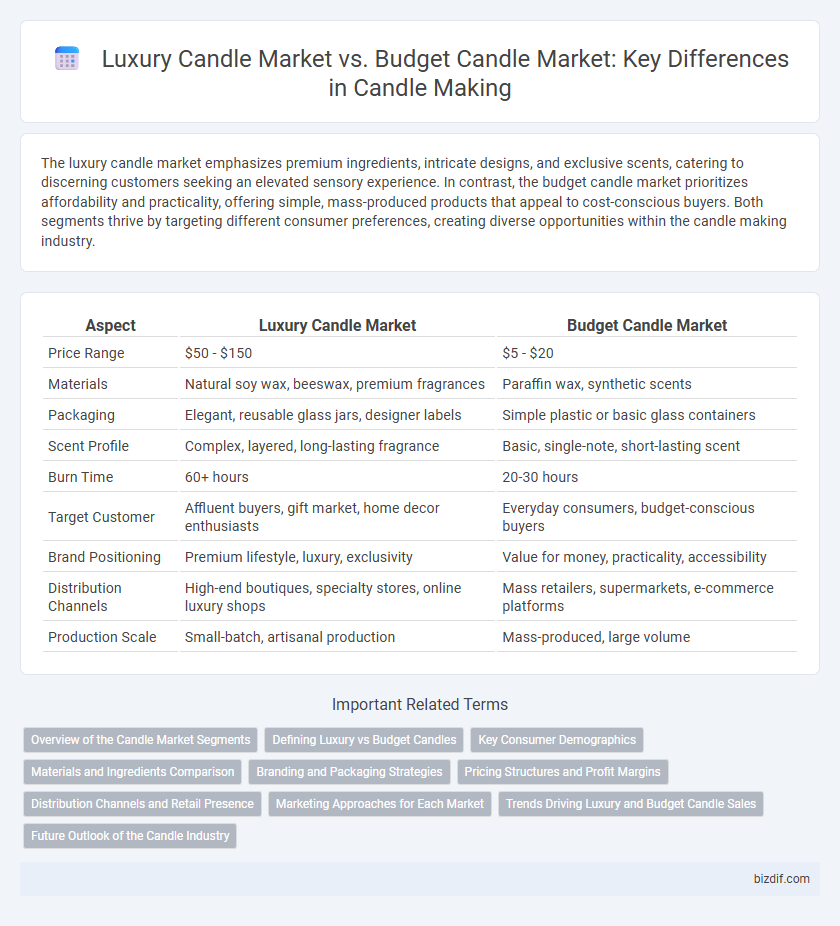The luxury candle market emphasizes premium ingredients, intricate designs, and exclusive scents, catering to discerning customers seeking an elevated sensory experience. In contrast, the budget candle market prioritizes affordability and practicality, offering simple, mass-produced products that appeal to cost-conscious buyers. Both segments thrive by targeting different consumer preferences, creating diverse opportunities within the candle making industry.
Table of Comparison
| Aspect | Luxury Candle Market | Budget Candle Market |
|---|---|---|
| Price Range | $50 - $150 | $5 - $20 |
| Materials | Natural soy wax, beeswax, premium fragrances | Paraffin wax, synthetic scents |
| Packaging | Elegant, reusable glass jars, designer labels | Simple plastic or basic glass containers |
| Scent Profile | Complex, layered, long-lasting fragrance | Basic, single-note, short-lasting scent |
| Burn Time | 60+ hours | 20-30 hours |
| Target Customer | Affluent buyers, gift market, home decor enthusiasts | Everyday consumers, budget-conscious buyers |
| Brand Positioning | Premium lifestyle, luxury, exclusivity | Value for money, practicality, accessibility |
| Distribution Channels | High-end boutiques, specialty stores, online luxury shops | Mass retailers, supermarkets, e-commerce platforms |
| Production Scale | Small-batch, artisanal production | Mass-produced, large volume |
Overview of the Candle Market Segments
The luxury candle market emphasizes premium materials such as natural wax blends, unique fragrance compositions, and elegant packaging, targeting affluent consumers seeking exclusive sensory experiences. In contrast, the budget candle market focuses on affordability, mass production, and simpler scent profiles, appealing to cost-conscious buyers prioritizing practicality over exclusivity. Market analysis reveals rising demand in the luxury segment driven by increasing disposable incomes and home decor trends, while the budget segment maintains steady growth fueled by everyday usage and accessibility.
Defining Luxury vs Budget Candles
Luxury candles distinguish themselves through premium ingredients such as high-quality soy or beeswax, complex fragrance blends, and elegant packaging, often appealing to sensory and aesthetic sophistication. Budget candles prioritize affordability, using paraffin wax and simpler scents, targeting mass-market consumers who seek functional illumination with minimal cost. The luxury market emphasizes exclusivity and artisanal craftsmanship, whereas the budget segment focuses on cost-efficiency and accessibility.
Key Consumer Demographics
The luxury candle market primarily attracts affluent consumers aged 30-55, with a strong preference for high-quality, artisanal ingredients and unique scent profiles that enhance home aesthetics. In contrast, the budget candle market appeals to younger consumers aged 18-30, who prioritize affordability and functional scents for everyday use. Urban dwellers and eco-conscious buyers increasingly influence both segments, demanding sustainable sourcing and packaging.
Materials and Ingredients Comparison
Luxury candles often utilize high-quality, natural materials such as soy or beeswax combined with pure essential oils, creating a cleaner burn and richer fragrance profile. Budget candles typically rely on paraffin wax and synthetic fragrances, resulting in a shorter burn time and less nuanced scent experience. The use of premium ingredients in luxury candles directly influences their higher price point and perceived value in the market.
Branding and Packaging Strategies
Luxury candle market brands prioritize premium packaging materials such as thick glass containers, intricate labels, and elegant gift boxes to convey exclusivity and sophistication. Budget candle brands focus on cost-effective, minimalist packaging designs that emphasize functionality and accessibility while maintaining clear brand identity. Effective branding strategies in the luxury segment highlight artisanal craftsmanship and fragrance complexity, whereas budget candles emphasize value, simplicity, and everyday usability.
Pricing Structures and Profit Margins
The luxury candle market commands premium pricing due to high-quality ingredients, artisanal craftsmanship, and exclusive packaging, generating profit margins often exceeding 60%. In contrast, the budget candle market relies on cost-efficient materials and mass production, leading to lower price points and slimmer profit margins typically around 20-30%. Brands targeting luxury segments benefit from strong brand loyalty and perceived value, while budget candles compete primarily on affordability and volume sales.
Distribution Channels and Retail Presence
The luxury candle market primarily relies on exclusive distribution channels such as high-end boutiques, specialty stores, and upscale department stores, enhancing brand prestige and targeting affluent consumers. In contrast, the budget candle market focuses on mass distribution through supermarkets, discount retailers, and online marketplaces, aiming for wide accessibility and competitive pricing. Retail presence for luxury candles often features curated in-store experiences and limited edition collections, while budget candles emphasize volume sales and broad availability.
Marketing Approaches for Each Market
Luxury candle market marketing strategies emphasize exclusivity, high-quality ingredients such as natural soy or beeswax, and sophisticated scents like rare botanicals to attract discerning customers willing to pay premium prices. Premium branding uses elegant packaging, limited editions, and influencer partnerships to create a sense of prestige and lifestyle aspiration. In contrast, budget candle market marketing focuses on affordability, wide distribution channels including mass retailers, and value-driven promotions such as bulk discounts or seasonal sales to appeal to cost-conscious consumers.
Trends Driving Luxury and Budget Candle Sales
The luxury candle market experiences growth driven by demand for artisanal craftsmanship, premium natural ingredients like soy wax and essential oils, and unique fragrance blends that evoke exclusivity and wellness. Budget candle sales surge due to affordability, mass-market appeal, and increased availability in discount retailers, with trends favoring simple scents and multipack offerings. Sustainability and eco-friendly packaging influence both segments, but luxury brands emphasize cruelty-free certifications and biodegradable materials, while budget brands focus on cost-effective, recyclable solutions.
Future Outlook of the Candle Industry
The luxury candle market is projected to experience robust growth driven by rising consumer demand for premium fragrances, high-quality ingredients, and artisanal craftsmanship that elevate home ambiance. In contrast, the budget candle market will maintain steady demand by appealing to cost-conscious consumers seeking affordable, functional options for everyday use. Overall, the candle industry is expected to diversify, with innovation in sustainable materials and unique scent blends fueling long-term expansion across both segments.
Luxury candle market vs Budget candle market Infographic

 bizdif.com
bizdif.com